The Parlour Collective (Jack Catling, Matthew Galpin, Pavana Reid, David Stearn) is an international collective that uses the language of site-specific performance based on the primary relationship between the physical action of the body and the natural context that we could define from time to time as an environment, territory, landscape, or at most, domestic interiors. The originality of the Parlour Collective’s works consists in the conceptualization, that is, in the eminently mental relationship with spaces of any nature. What we now commonly define as Performance takes on the analytical, mental and eidetic characteristics of the art of behavior in the collective’s works. It is consequently a procedural art that presupposes a direct relationship between the artist and the chosen environment to build a reciprocity of some kind. In particular, the group is interested in enhancing the relationship between space, memory, cultural heritage through the combination of actions capable of revealing the essence of the genius loci.
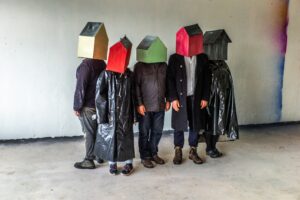
Parlour Collective, 2022, photo Omar Sejnaes, courtesy of the artists
Piero Deggiovanni: During your performances you act by wearing objects or using them in an atypical, bizarre way, but they are anything but shamanic objects, rather they seem to be mental extensions, interpretations or ideal excrescences of the territory itself, is that right?
Parlour Collective: The role of objects shifted gradually throughout the different films. Initially, in Shifting Landscapes, the objects we used took on more of a role of links between our individual artistic practice, and the new environment. We also used a selection of found objects from within the Surnedal Billag, the boatshed, by the side of the road or in the hills. As this progressed we found the brought objects too familiar and therefore too limiting, leading us in the later films to move fully to objects found or created in the place itself. Through Scenes, Overheard and subsequently, objects were chosen as extensions of possibility, not things in themselves, to be used or not depending on what the landscape demanded – there were totems, or object-motifs that seemed to appear more frequently, such as the chair, the ladder, the boat – objects that perhaps joined the synthesis as a conduit or a bridge, not demanding in their object-ness, or containing a suggestion of movement/presence/absence in keeping with the rhythm of the actions and the territory.
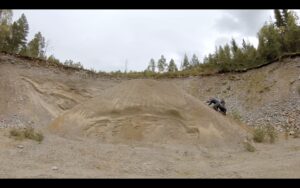
Parlour Collective, “Shifitng Landscapes”, 2020, video still, courtesy of the artists
Let’s talk about your choice to be site-specific. It seems to me that every performative action is a conceptual and soul photograph of the character of a certain place, an unrepeatable action in other contexts, therefore, it is a unique act. It reveals the genius loci in its still infantile and primordial phase, that is, before men transform it into a productive tool, inserted into the capitalist economic process. Do you agree with this reading of your work?
In some ways we agree. The main thing that emerged accidentally from the process was the act of play, or the ludic act, as a productive instrument in itself. Playing within a genius loci place and time, and through play gradually revealing its form, but with an equality that is to play is also to allow for the landscape to play with you. Play is unrepeatable and site-specific by its very nature, and each act of play contains each individual, the landscape, the camera, all in play together, with a collision of our hidden individual thoughts. The most difficult part was reaching the possibility of play, the right environment for elements of the naive to form, trial and error – not necessarily infantile – but to be fully human, in all its potential (something that merges with every part of life, even the capitalist system).
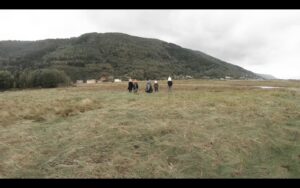
Parlour Collective, “Shifitng Landscapes”, 2020, video still, courtesy of the artists
Let’s now talk about the formal precision of your actions. I think that the particular conceptual synergy that you build, tends to extrapolate internal relationships between given elements that go well beyond direct perceptual experience; it is an interpretation that awakens “sleeping” ideal entities in the landscape. Acting in it, and through it, it defines relationships capable of revealing the reality statuses of anthropic or natural space. Your iconic formalism finds its raison d’etre in the attempt to construct, through the action of the body, a statement capable of illustrating the symbolic and semantic relationship between the mind, memory and space. What do you think about this?
For us formalism is something that emerges after the fact, or maybe during the duration of performance/filmmaking itself, a process of accidental precisions. Any designs in that capacity emerge from fragments of mind, memory and place, pushed through unexpected trance-like moments of the imagination. The works search for a relationship with these elements, but not so much a depiction but the thing itself, which is something more malleable, shifting and out of our control. It is closer to a chipping away, where the sleeping ideal forms and entities begin to emerge but then vanish/metamorphose just as quickly, never revealed in their fullness, but absorbing us. The film becomes one expression of the fragments we have captured, but there is the potential for others.
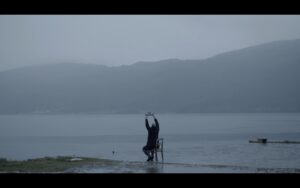
Parlour Collective, “Scenes, Overheard” 2022, video still, courtesy of the artists
Before going into the specifics of your films, could you tell us about this curious combination of film and performance? In other words, why did you decide to use the video medium to integrate and disseminate site-specific works?
Documentation of performance is a difficult thing to achieve, which led us to try different approaches to capturing our specific type of live site-specific performance work (a method of ‘haunting’ spaces through peripheral acts, connecting with the latent potency of places or buildings.), such as having a writer in residence etc. The move toward using the video medium in a more meaningful way emerged organically during a residency at Surnadal Billag, Norway. The nature of working in a landscape such as this lent itself to the image, balancing a sense of space with a sense of action, and fostering a relationship between them that can be experienced second-hand without one eclipsing the other. The conversations turned to painting, and the way some landscape compositions such as those by Paul Nash or Giorgio Morandi would work with presence/absence/movement/landscape/time. Through the different films, the camera developed its role, from Shifting Landscapes, where the camera sets out a particular narrative through its capturing, it quickly took on its own ground as active participant, performing the roles of gaze, composer and marker of time, opening up new possibilities for our work. The nature of working in landscape lends itself to the image, to understand the sense of space, the sense of time, and how the action is placed.
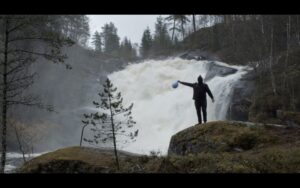
Parlour Collective, “Scenes, Overheard” 2022, video still, courtesy of the artists
The three films we mention here – Shifting Landscapes (2020); Scenes, Overheard (2022); Forest Scenes (2022) – can be configured as three acts of a single performative cosmogony. Filmed entirely in the Norwegian territory of a small village, the films are made up almost entirely of fixed camera sequences in order to give ample scope to the performative actions and, as you declare, you were inspired by the cinema of Buster Keaton. This seems to be an interesting element since Keaton’s comedy has something absurd and seems proto-Beckettian, but on a technical and filmic level, what does the reference to the American actor and director consist of?
The reference to Buster Keaton is closer to his filmmaking ruleset, the adaptation of which enhanced our potential for the accidental. Keaton’s treatment of the camera frame as its own world with its inherent geometric rules (the vertical and horizontal acting in a similar nature to the proscenium arch stage), and the overlaps with those of landscape painting. This was useful as a way of presenting action, landscape and time in the same scene without sacrificing the presence of one of these elements over the others. These worlds also contain their own ways of measuring time through rhythm, stillness and action, something that can be seen in a lot of Keaton’s scenes. This notion of portraying time through action is something we wished to explore through the films, along with ways different rhythms of time can exist in the same scene, overlapping with another point of inspiration; the theory of Jo-ha-kyū, a mechanism in Japanese theatre of modulating movement and time. Another influence emerging from silent film was the work of the actor Harry Langdon, whose presence is minimised within the filmic frame, with his actions being an off-centre balance between absence and presence, weaving the scenes together. This overlap can be seen most keenly in the unfolding action of Forest Scene; its natural stage-like setting broken up with verticals of trees, and the receding horizontal patterns of the hills where the characters shift in and out of visibility, growing and shrinking in size.
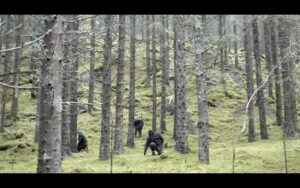
Parlour Collective, “Forest Scene”, 2022, video still, courtesy of the artists
What role does chance play in the creation of both the actions and their film version? In other words, does post production have the ability to “correct” or perfect what you have done in real space?
Chance plays a huge role in the actions and the way they are filmed. As discussed before, the ludic act of play is inherent to the way in which we work, and therefore relies on chance to navigate the intertwining with landscape and action. The locations are discovered through chance, and the actions spring from them through chance. In this way, we capture a large amount of footage, with the editing process as a way of making sense of it (sometimes long after the events), more through composition than correction. The post-production process becomes a chance to try and reveal the immediacy and feeling of being in the landscape and what we were experiencing when making the actions/film, understanding the experience through conversation and experimentation. The films themselves are not seen as the only manifestation of the work, each of the scenes we have worked on carry the potential of being shown in different ways and in different constellations, with the possibility of endless re-composition.
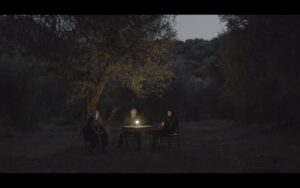
Parlour Collective, “One Place, Another”, 2023, video still, courtesy of the artists
Let’s now talk about your latest film shot in Tuscany. I know it has yet to be officially published but I find what you told me about the state of mind it aroused in you very interesting. Instead of you being interpreters of the place, in some way it interpreted you, inducing you to generate actions that are more miraculous than conceptual interpretations of the territory. Your gesture was in perfect spiritual harmony with the landscape. How do you explain it?
When arriving in Tuscany to make the new film From One Place, Another, we were presented with a landscape resistant to the tools and methods we had developed while in Norway. We tried several different approaches, certain things presented themselves to be worked through, with various shades of tension, struggle and play, but it seemed that until the landscape agreed to begin speaking with us (or perhaps through us), progress was slow. Once an agreement had been reached, images began to spring into the mind, and translate themselves to actions seen in the film. At the time, it was difficult to recognise, it wasn’t until returning to the UK and the editing process, and subsequent conversations that we began to see what we had and hadn’t channelled. The film was hidden within the footage, spectral moments emerging between the gaps.
Info:
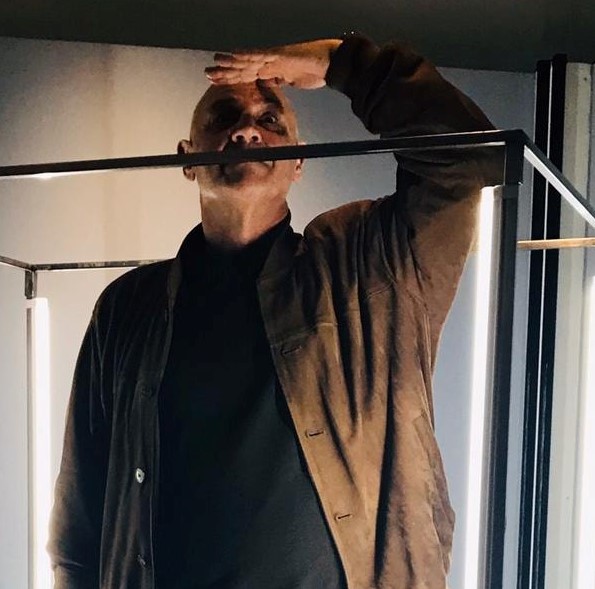
Piero Deggiovanni (Lugo, 1957) is a professor of History of Contemporary Art and History and Theory of New Media at the Academy of Fine Arts in Bologna and at LABA in Rimini. He is a critic and researcher in the field of contemporary art, member of the scientific committee of the Videoart Yearbook, Bologna University. For several years he has dedicated himself exclusively to research, focusing on video art and experimental cinema.






NO COMMENT